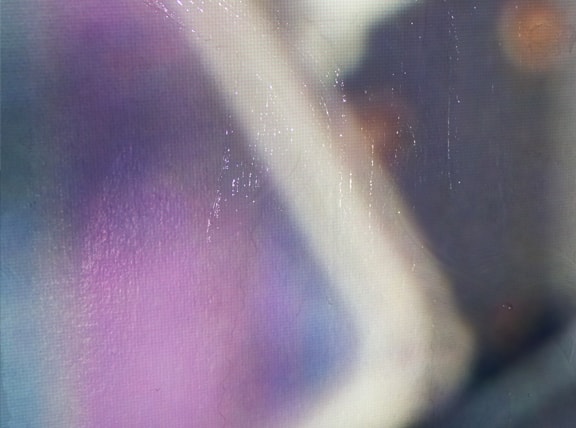exhibitions

STUDIO 12 | JOSHUA PETHERICK: GLASS TABLES
–
Glass Tables
Joshua Petherick
Studio 12
Exhibition Dates: 24 August - 22 September, 2012
Opening Night: Friday 24 August, 6-8pm
Petherick's multi-disciplinary practice considers media and material in a constant state of shifting in and out of any fixed body. His installations of sculpture, video/audio and "image objects" place emphasis on the grey areas that open up through systems of manifold production and translation, from one context or material to the next. The devices, structural principles and parergon that surround or support an artwork become central to the work itself, as do the qualities of chance and misunderstanding that accompany acts of translation and process. Petherick presented his "Glass Tables", a recalibration of a recent video work in the studio 12 gallery.
Recent presentations include: Nachinat-Glazz-Smot-Messel-Vareet-Dorogoy, 2012, The Common Guild (for Glasgow International Festival of Visual Art 2012), Glasgow; Chinatown, the Sequel, 2012, curated by Liv Barrett, Los Angeles; Big Refrigerator, 2012, Hopkinson Cundy, Auckland; Saratogian Bedding (solo), 2011, Croy Nielsen, Berlin; Social Sculpture, 2011, curated by Charlotte Day, Anna Schwartz Gallery, Sydney; ACCA ART#2, 2011, curated by Hannah Mathews and Juliana Engberg, Horsham Art Gallery, Australia; with forthcoming solo presentations at The Vanity, Los Angeles (2012) and Centre for Contemporary Photography, Melbourne (2013).
Joshua Petherick is represented by Hopkinson Cundy, Auckland and Croy Nielsen, Berlin.
JOSHUA PETHERICK
GLASS TABLES
Catalog text produced for Gertrude Contemporary and Art and Australia Emerging Writers Program -
Conversation can be understood as a type of circular feedback, whereby dialogue forms a progressive loop upon itself. As one talks with an other, the situation grows to reach a point beyond itself. Existing in flux, it moves, shifts and morphs as it evolves. Joshua Petherick’s practice loops similarly, drawing at once from itself and from exterior reference points as he operates with the variables of chance, association and misinterpretation.
In Glass Tables, Joshua Petherick has sourced his material from the everyday. He documents a conversation between a flatbed scanner and an iPhone as they begin to survey, record, and transcribe each other. Glass Tables demonstrates the artist’s engagement with layered processes of copying, translating, re-working and editing, often informed by the materials at hand. A rich recent history exists of artists drawing upon the everyday to uncover ideas in smaller places. What differentiates Petherick is his ability to provide insight into the things that we do not and cannot actually see, both literally and in a much wider sense. Petherick conducts a situation where devices are pushed beyond their typical functional roles to become objects talking to each other. In the artist’s words, they are ‘devices for looking, tracing devices for looking.’ A sort of reflexive feedback loop is produced between devices as each attempts to execute its usual behaviour, unaware that the other is in this exact same process. In the work we witness the documentation of this relationship between two everyday items. What has been documented is the intangible: an interaction that is otherwise invisible to the human eye. We witness a kind of secret relationship between objects, joined in their utilitarian purpose, which in this instance performs no useful function.
The artist’s practice has been informed by many reference points, drawing from a wide scholarly interest in philosophical, cultural, art-historical and literary fields. This research approach is demonstrated through Petherick’s interest and work in design, music, sound and publication projects. Glass Tables draws from specific art historical and literary inquiry by the artist and is a product of his interdisciplinary research approach. In particular, George Baker’s book Artwork Caught By The Tail has recently re-surfaced for Petherick to inform his ideas for Glass Tables. Baker explores in some depth a similar approach to practice as Petherick, speaking much of the ‘interregnum: a place in between, between forms’. Expanding upon the notion of the space in between, Petherick composes a work that is produced entirely through current-day technological apparatus, yet in the same instance references pivotal traditional art historical movements such as Colour Field painting. Through this, Petherick draws from different points across time to present moments that in themselves seem to move beyond time as a reference. These moments remain undefined by time, instead offering a chance for viewers to slow down and focus on a moment that mimics, but escapes, the imprecise, ambiguous process of language.
In this work Petherick creates a sequence where different responses are not just possible, but encouraged. The viewer’s eye traces an ambiguous image. One may become lost within a murky lulling, with vision shifting in and out of focus, drifting with the meditative flow of the audio-visual concourse. Then occasionally, disruptions appear in the image in the form of linear colour-burst sparks which move, disrupt and build upon themselves as they slide down the image at particular intervals. The work can be viewed as an entire archive in motion, made up of a single changing picture, or perhaps rather a sequence of frames. Petherick allows his audience to find their own moment within the work, to become the arbiter of choice where, in the artist’s words, ‘the viewer’s own gaze enters the fold of image production’ and furthermore this enables the viewer to become part of a ‘reflexive sequence of lenses, or looking glasses.’ (1) Thus, Petherick acknowledges that subjective responses inform the translation process, and indeed permit it to become yet a further variable within the work itself.
In his back-and-forth between the minute and the limitless, the tangible and the invisible, Petherick guides us to notions of the infinite. Petherick employs a deliberateness in wanting to ensure we are also aware of the actual nothingness that resides in such mundane objects. Ultimately, the work isn’t about the objects or their perceived use-value: it is about us.
------
(1) Joshua Petherick, from interview with the author
TESS MAUNDER